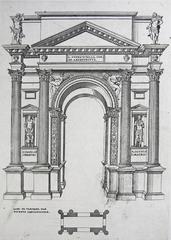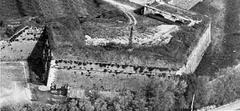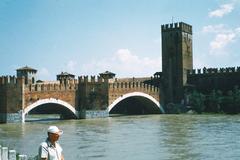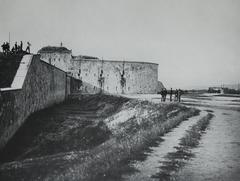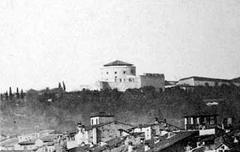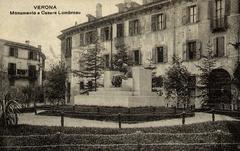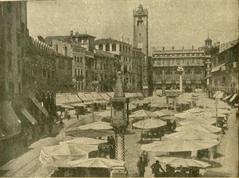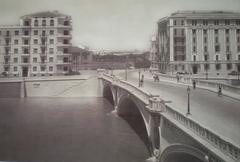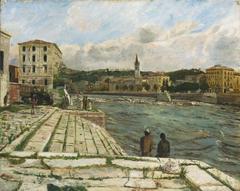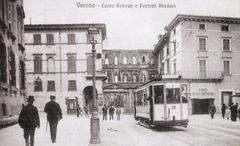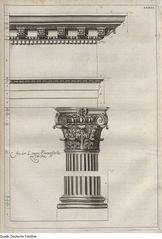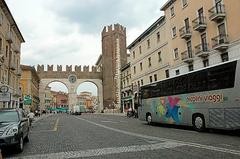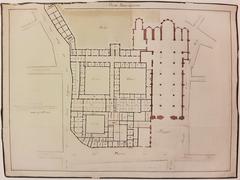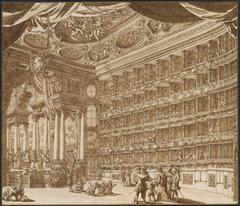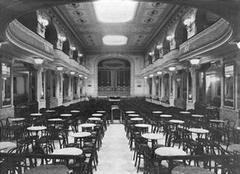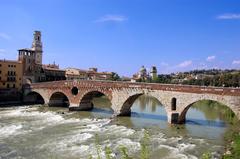
Case Mazzanti Verona, Italy: Visiting Hours, Tickets, and Historical Significance
Date: 04/07/2025
Introduction
Situated in the heart of Verona’s historic Piazza delle Erbe, Case Mazzanti is a striking emblem of Renaissance artistry and medieval heritage. Easily recognizable by its vividly frescoed façades, the building encapsulates the city’s reputation as the “Urbs Picta”—the painted city—where art, architecture, and commerce have intermingled for centuries. From its origins in the 13th century, closely tied to the powerful Scaligeri family, to its Renaissance transformation under the Mazzanti family, Case Mazzanti offers visitors a unique window into Verona’s layered past and enduring cultural identity.
This guide provides comprehensive information on visiting hours, ticketing, guided experiences, architectural highlights, and practical travel tips, enabling visitors to fully appreciate the historical and artistic significance of this Verona landmark. For the latest updates, always refer to official sources such as the Verona Tourism Official Site and the UNESCO World Heritage page for Verona.
Table of Contents
- Introduction
- Visiting Information (Hours, Tickets, Tours)
- Historical Overview
- Architectural and Artistic Significance
- Visiting Experience
- Frequently Asked Questions (FAQ)
- Visuals and Media Suggestions
- Internal and External Links
- Conclusion
- References
Visiting Information: Hours, Tickets, and Tours
- Viewing the Facades: The frescoes and ground-floor arcades of Case Mazzanti are freely visible from Piazza delle Erbe at any time, year-round.
- Interior Access: The interiors are private and generally closed to the public, except during special events, property viewings, or pre-arranged guided tours.
- Tickets: No ticket is required to view the exterior. Guided tours that include interior commentary or rare access are offered by select local agencies; prices vary.
- Guided Tours: Many walking tours of Verona’s historic center include Case Mazzanti as a key stop (exterior only). Check with local providers or official tourism platforms for availability.
- Accessibility: The piazza and ground-floor arcades are wheelchair and stroller accessible. Interior access is typically not barrier-free due to the historic nature of the building.
Historical Overview
Medieval Origins & Scaligeri Influence
Case Mazzanti stands on the site of an ancient Roman building, with its earliest documented structure dating back to the late 13th century. The Scaligeri family, Verona’s medieval rulers, rebuilt the property between 1277 and 1301, using it for both grain storage and commercial activity due to its strategic location between the Domus Mercatorum and the bustling market square (Nomadic Niko). The building’s history is indelibly marked by the assassination of Mastino I della Scala within its walls in 1277, a pivotal event in the city’s political narrative.
Renaissance Transformation
The Renaissance era ushered in a new chapter for Case Mazzanti. In 1527, the Mazzanti family acquired the property and commissioned Mantuan painter Alberto Cavalli, a pupil of Giulio Romano, to embellish the façade with vibrant frescoes. Completed by 1529, these artworks transformed the building into one of Verona’s most outstanding Renaissance landmarks, reflecting the intellectual and artistic currents of the time (visitverona.it).
Architectural and Artistic Significance
Façade Frescoes: The “Urbs Picta” Legacy
Case Mazzanti epitomizes Verona’s tradition as a “painted city.” Its outward-facing walls are adorned with approximately 400 square meters of Renaissance frescoes, featuring mythological and allegorical scenes, ornamental motifs, and intricate color palettes (Learn more about Case Mazzanti frescoes). This decorative program was not merely aesthetic; it conveyed the prestige, cultural aspirations, and social status of the Mazzanti family.
Despite centuries of weathering, Case Mazzanti stands as the city’s most prominent surviving example of this tradition, with restoration efforts ensuring the visibility of its painted splendor (ad-italia.it).
Structural Features
The building’s ground floor features a Renaissance loggia with 15 arches supported by 16 columns, each bearing distinct family coats of arms. Above, four main stories and a mezzanine are punctuated by mullioned windows and 19th-century stone balconies that harmonize with the Renaissance design (Explore Case Mazzanti architecture). The rear of the building preserves a medieval well, and the interior (when accessible) boasts coffered ceilings, Venetian terrazzo floors, and original woodwork.
Noteworthy Elements
- Panoramic Terrace: Offers sweeping views over Piazza delle Erbe and Verona’s historic skyline.
- Cantina: The basement features original 14th-century paving and echoes the building’s origins as a granary.
- Medieval Well: An authentic feature reflecting the practical needs of historic urban dwellings.
Preservation and Restoration
Recent conservation initiatives—most notably between 2020 and 2022—have focused on stabilizing the frescoes and preserving the building’s architectural integrity, securing its status within the UNESCO World Heritage site designation (Restoration details).
Visiting Experience
What to See and Do
- Admire the Frescoes: The best vantage points are from the southern side of Piazza delle Erbe, especially in the morning or late afternoon when natural light highlights the colors.
- Photograph Architectural Details: Focus on the painted façade, loggia, and decorative stonework.
- Enjoy the Piazza: Savor local cuisine at ground-floor bars or restaurants, many with outdoor seating.
- Join a Guided Tour: Enhance your understanding of Case Mazzanti and Verona’s Renaissance heritage through a walking tour.
Accessibility
- The piazza and arcades are accessible for wheelchairs and strollers.
- Upper floors and interior spaces are generally not accessible due to the historic layout.
Nearby Attractions
- Torre dei Lamberti: Scenic city views from the tower (elevator available).
- Palazzo Maffei: Baroque palace with art collections.
- Juliet’s House: Iconic literary site within walking distance.
- Domus Mercatorum: Medieval merchant guild headquarters.
Visitor Tips
- Best Visiting Times: Early morning or late afternoon for optimal lighting and fewer crowds.
- Footwear: Wear comfortable shoes for cobblestone streets.
- Etiquette: Respect the privacy of residents—avoid photographing through windows or private entrances.
- Amenities: Public restrooms available in the square; cafés and shops on the ground floor.
Frequently Asked Questions (FAQ)
Q: What are the visiting hours for Case Mazzanti?
A: The exterior frescoes and arcades are visible at all hours from Piazza delle Erbe. Interiors are private except for special openings or guided tours.
Q: Is there an entrance fee?
A: No ticket is required to view the exterior; guided tours may have a fee.
Q: Are guided tours available?
A: Yes, many Verona walking tours stop at Case Mazzanti (exterior commentary only). Interior tours are rare and by reservation (Verona Guide).
Q: Is the site accessible for wheelchair users?
A: The piazza and arcades are accessible, but the upper floors are not.
Q: How can I book a tour?
A: Book through local tour agencies, Verona Guide, or the official Verona Tourism Office.
Visuals and Media Suggestions
- High-resolution photos of the façade and loggia with descriptive alt text such as “Renaissance frescoes on Case Mazzanti, Piazza delle Erbe.”
- Interactive map pinpointing Case Mazzanti and nearby landmarks.
- Video or virtual tour links via Verona tourism platforms.
Internal and External Links
- Internal: Related articles on “Top Renaissance Landmarks in Verona” and “Visiting Piazza delle Erbe.”
- External:
Conclusion
Case Mazzanti stands as a living masterpiece in Verona’s historic core, its frescoed façades bearing witness to centuries of artistic brilliance, political intrigue, and urban evolution. While interior visits are rare, the building’s public-facing art and architecture make it an essential stop for anyone exploring the city’s Renaissance and medieval heritage. Plan your visit to coincide with off-peak hours, consider a guided walking tour, and be sure to explore the wealth of nearby attractions in Piazza delle Erbe.
For current information on special openings, events, or tours, consult the Verona Tourism Official Site or download the Audiala app for personalized travel tips and updates. Let Case Mazzanti inspire your journey through Verona’s timeless charm.
References
- Verona Tourism Official Site
- Visit Verona
- Case Mazzanti on Wikipedia
- Bimbe in Viaggio: What to See in Verona
- Nomadic Niko: Piazza delle Erbe and Case Mazzanti
- Verona Oggi: Case Mazzanti Events
- Food Walk Verona: History of the Painted City
- Timeless Travel Steps: Mazzanti Houses Overview
- ad-italia.it: Case Mazzanti Architecture and Art
- Explore Case Mazzanti Architecture



